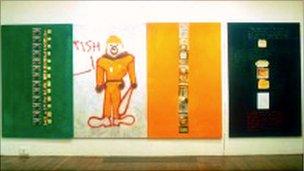Controversial Bloody Sunday painting back in Belfast
- Published

Staff at the Ulster Museum refused to hang 'Silver Liberties' in 1978
A controversial painting banned from the Ulster Museum more than three decades ago is being displayed for the first time in Northern Ireland.
Conrad Atkinson's 'Silver Liberties' commemorates the victims of Bloody Sunday.
In 1978, staff at the museum refused to display the work.
The painting is part of an exhibition at Belfast's Golden Thread Gallery curated by the politician and publisher Mairtin O Muilleoir.
He thinks that it is highly significant that the piece can now be displayed in the city.
"It's a milestone in the city's move towards peace; we are working to right a wrong," he said.
"It's a piece of art which is against violence."
'Silver Liberties: A Souvenir of a Wonderful Anniversary Year,' is made up of four panels, three in the colours of the Irish flag. The fourth panel is black.
The first panel includes photos of the 13 people killed on Bloody Sunday and a blood-stained banner carried on the day of the march.
It made headlines in 1978 when porters at the Ulster Museum refused to hang the painting.
The museum's trustees supported their action at the time.
Since then, the painting has been housed in Wolverhampton Art Gallery.
'Cultural paramilitaries'
Cumbrian artist Conrad Atkinson's work has been displayed in galleries across the globe, including Tate Britain in London and the Victoria and Albert museum.
He said that 'Silver Liberties' was initially commissioned by Nicholas Serota, now the director of the Tate, to celebrate the Silver Jubilee of the Queen.
Mr Atkinson said he decided to do "something kind of unusual".
"I wanted to tell the English about the situation in Northern Ireland, and how civil liberties were being eroded in Great Britain as a whole.
"The painting's real home is in London in a sense," he explains.
He said he was not surprised by what happened in 1978, but still felt the museum's trustees of the time were "cultural paramilitaries".
Mr Atkinson said that his feelings about Bloody Sunday motivated the work, but that it also had a wider focus.
"I thought about Picasso's Guernica when I was making it," he said.
"Contrary to what people think, the dead body in the fourth panel is not an IRA man or a loyalist paramilitary."
Instead, the picture is of a man called Liddle Towers, who died in 1976 from injuries received at the hands of the police in Co Durham.
'Peace rather than politics'
Martin O Muilleoir counters suggestions that the exhibition contains art from only one political persepctive.
"People need to come and look at it," he said.
"We told the story through my story of growing up. It's from my perspective.
"I hope they'll appreciate it as a show about peace rather than politics."
The exhibition, called 'Tears in Rain,' also includes work by the well-known artists Rita Duffy, Robert Ballagh and F.E. McWilliam.
It runs at the Golden Thread Gallery in Belfast until 3 December.